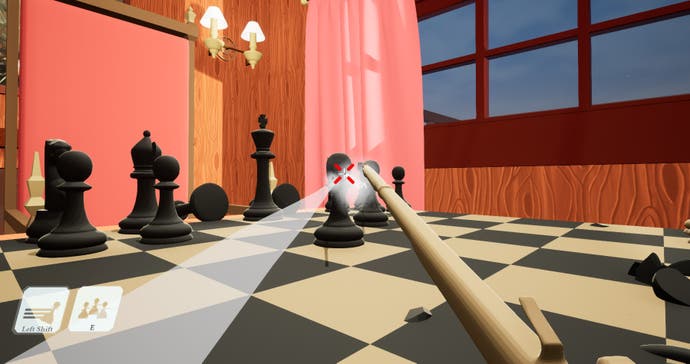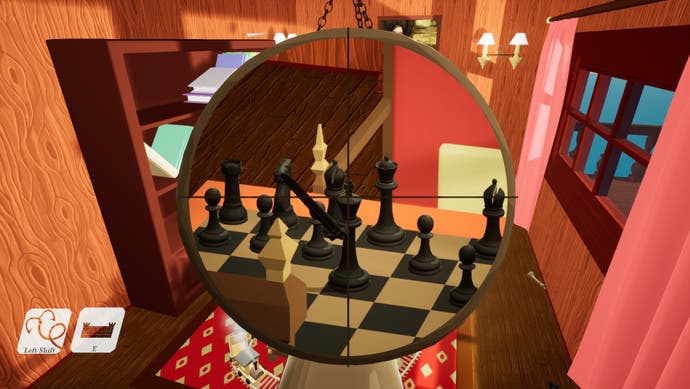FPS Chess joins the ranks of rulebreakers teasing new meaning from the game
Pawned.
FPS Chess is, as its name suggests, chess, with a first-person twist. Then again, the title also raises a good question: is chess already played in first person? When we sit down to a match, are we assuming the role of a general, surveying the carved pastures of war? Or are we narrators at a third-person remove, telling the story of each piece, as it slides toward ruin or triumph?
The crux of FPS Chess, which released last year on Steam, and which you can download free of charge, is simple. Seated in a warm study (bookshelf, crackling hearth, model train humming over a prairie of carpet), you play a match against someone online: a friend or a stranger. No character sits opposite you, and both your pieces and your opponent's move of their own accord, hopping where you point. Though, it must be said, no actual pointing is done. Unlike Inscryption - another game about a game, which enfolded you in wood and warm darkness but had nastiness on the cards-no hands reach out.

Every time a piece attempts a capture, we cut to first person for the ensuing bout. Battle is joined on the board and off, tumbling from the table onto the chairs and shelves, into the fire, even onto the carriages of the train. At this point, one might presume that any connection to real chess has wobbled off the rails; in truth, it has merely taken an unexpected track. FPS Chess encases the ancient game in the mechanics of the hero shooter, changing the patterns of its play; and in so doing it varnishes the pieces with character, lending their gestures a sharp, familiar purpose. Look at the bishops, brandishing Holy Hand Grenades and gliding, on borrowed wings, into battle. And watch the queen, wielding a Gatling gun and hurling pieces with regal telepathy. Pick a fight with her, and you feel as you did at the approach of a Big Sister, in BioShock 2. The world cracks and panic floods in.

FPS Chess pays homage to its inspiration by breaking its rules. Thus, it joins the ranks of variations that have hovered at the margins of chess throughout history. Think of Chess960, dreamed up by Bobby Fischer, which randomises the placement of pieces, in an effort to drag players out of the dusty realms of theoryA and into a domain of pure and unhinged creativity. Dunsany's chess, meanwhile, arms Black with a traditional setup but equips White with a battalion of thirty-two pawns. Its creator, Lord Dunsany, fought in the First World War, so perhaps it's little wonder that he bequeathed us an asymmetric horde mode. Chess may have arrived, early in the eighth century, in remarkably recognisable form, and it may not have been lavished with many patches or any substantial post-launch content. But with a modding community like this, who cares?
These variants may cease to be chess, but they never cease to be about chess. In mocking its rules, they tease out fresh meaning. They remind us that to lampoon is, fundamentally, an act of love, and they press the game through the obsessed prism of their makers. Hence the enduring image of FPS Chess, the one we see at the end of each confrontation: the defeated piece cracked, and crumbling into powdery shards. You relish the theatre, you appreciate the way the antique game has been toyed with and broken up, if only for a brief moment, but you know that the next move awaits, and the one after. The game underneath is untouched, standing firm even as it falls to pieces.
